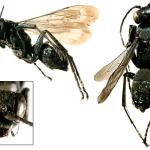Anoplius atricolor (Moczar, 1944); A. carbonarius (Haupt, 1937); A. cardui (Perkins, 1917);
A medium-sized black pompilid. Most records of this species are old, suggesting a decline, or perhaps just elusiveness on the part of the wasp.
A species with a very local distribution in southern Britain, although there is a recent record from Tyddyn Bach, Gwynedd, by J T Burn (pers. comm.), and another from Wrexham, Clwyd, by M Edwards (pers. comm.).
Listed in Falk (1991) as Nationally Notable (Nb). Work for this Atlas has shown that it is more rare than had previously been thought.
Day, 1988 is the standard work for identifying British Pompilidae. Wiśniowski, B., 2009 is also useful.
Anoplius caviventris is associated with rough vegetation that provides plenty of hollow stems of plants such as thistles, umbellifers, brambles and reeds. The habitats involved include marshes, riversides, meadows, heaths and open areas in woods. At Wicken Fen, Cambridgeshire, Spooner (1931) noted that it frequented heaps of dry sedge.
Adults are found from May to September, usually running over rough vegetation. It may be easier to record this species by looking for nests, or trap-nesting, rather than searching for adults.
Nest cells are usually provisioned with spiders of the family Clubionidae, but at Chippenham, Cambridgeshire, it was found with Tibellus maritimus (Thomisidae) (J P Field, pers. comm.).
Nesting occurs in dead, hollow stems of the sorts of plants listed above (e.g. Chambers 1948), and also in deserted aculeate burrows in dead wood (Richards & Hamm, 1939). The nest cells are arranged serially with partitions constructed of vegetable detritus (Day, 1988). Descriptions of British nests in dead thistle stems, and an old Ectemnius continuus (Crabronidae) nest in dead wood, are given by Perkins (1917), Richards and Hamm (1939) and Blair (1944).
1997


